“Excellent ‘return’ ethnography that focuses accurately on major issues facing contemporary Inuit in the 21st century. From the writing, the depth of knowledge, and relationships McElroy has with community members and concern for their well-being reflects the very best of ethnographic work that we wish to portray to our students.” — Kristen Borre, Northern Illinois University
“Nunavut Generations has a great deal to offer students of Inuit studies and is a suitable ethnography for a broad range of courses, including introductory anthropology and peoples and cultures of the Circumpolar North. In addition to being clearly written, McElroy’s text exposes the trials and tribulations of anthropological research. The fieldwork stories interspersed throughout the text are both poignant and inspirational. As is the case with the recent history of Nunavut, so it is true of cultural anthropology in general: both are journeys fraught with unanticipated challenges and unexpected opportunities.” — Edmund Searles, Etudes/Inuit/Studies
“This is an outstanding examination of Nunavumiut sociocultural dynamics through the last fifty years. McElroy skillfully blends elements of her own research (and personal experiences) with a critical overview of the social, economic, and political developments affecting Inuit in the late twentieth century. This work captures the nuances, as well as the ‘facts,’ leading up to and during the creation of Nunavut.” — George Wenzel, McGill University
“An erudite book on the process of doing ethnographic research and the nature of interactions with people in the field. Excellent for students with no prior research experience.” — Wanni Anderson, Brown University

187 pages, $25.95 list
1-57766-489-2
978-1-57766-489-5
© 2008
paperback
eBook availability
Nunavut Generations
Change and Continuity in Canadian Inuit Communities
Change in arctic populations has not been a sudden phenomenon, but rather a gradual process that has occurred over a number of generations. In this longitudinal case study, McElroy introduces readers to four Baffin Island communities in the eastern Canadian Arctic and focuses on the challenges and hardships they face in transition from hunting-gathering lifestyles to wage employment and political participation in towns. Through long-term fieldwork, historical material, and life histories collected from elders, Nunavut Generations richly illustrates political and ecological change alongside native stability and self-determination.
Reactions
1. Inuit and Astronauts
The Human Geography of Nunavut / What Is the Difference between "Inuit" and "Eskimos"? / The Theme of "Generation" / Adaptation and the Colonial Footprint / Organization of the Book / Why This Book?
2. Early Encounters
Ancestors and Origins / Contacts with Europeans in Eastern Canada / Commercial Whaling / Inuit as Cultural Brokers / Trading Companies / Memories of Traders
3. Dance from the Heart
The Myth of Sedna / Missionaries / Traditional Inuit Healing and the Arrival of Western Medicine / Royal Canadian Mounted Police / Military Influences
4. Living with the People
First Fieldwork / A Humbling Experience: Field Notes / Mosquitoes, Tourists, and Anthropologists / Doctoral Research / 1992 to 2006
5. Becoming Townspeople
An Inuit Perspective on Migration / Moving to Iqaluit / Moving to Pangnirtung / Moving to Cape Dorset (Kinngait) / Moving to Qikiqtarjuaq / Memories of Living in Town
6. Growing Up Biculturally
Birth and Neonatal Care / Naming Practices / Infancy / The Toddler / Encountering a Wider World / The Middle Years / Teachers and School Principals / What Did Inuit Parents Want? / The Extinction Myth: A Series of Flawed Assumptions
7. Relocation and Loss
A Traumatized Generation / Mina and Lucassie
8. Finding a Political Voice
The Dream of Nunavut / Impacts of Nunavut / Elders' Views of Nunavut / Food Security in Nunavut / A Vision for Nunavut
Epilogue
Glossary
The Human Geography of Nunavut / What Is the Difference between "Inuit" and "Eskimos"? / The Theme of "Generation" / Adaptation and the Colonial Footprint / Organization of the Book / Why This Book?
2. Early Encounters
Ancestors and Origins / Contacts with Europeans in Eastern Canada / Commercial Whaling / Inuit as Cultural Brokers / Trading Companies / Memories of Traders
3. Dance from the Heart
The Myth of Sedna / Missionaries / Traditional Inuit Healing and the Arrival of Western Medicine / Royal Canadian Mounted Police / Military Influences
4. Living with the People
First Fieldwork / A Humbling Experience: Field Notes / Mosquitoes, Tourists, and Anthropologists / Doctoral Research / 1992 to 2006
5. Becoming Townspeople
An Inuit Perspective on Migration / Moving to Iqaluit / Moving to Pangnirtung / Moving to Cape Dorset (Kinngait) / Moving to Qikiqtarjuaq / Memories of Living in Town
6. Growing Up Biculturally
Birth and Neonatal Care / Naming Practices / Infancy / The Toddler / Encountering a Wider World / The Middle Years / Teachers and School Principals / What Did Inuit Parents Want? / The Extinction Myth: A Series of Flawed Assumptions
7. Relocation and Loss
A Traumatized Generation / Mina and Lucassie
8. Finding a Political Voice
The Dream of Nunavut / Impacts of Nunavut / Elders' Views of Nunavut / Food Security in Nunavut / A Vision for Nunavut
Epilogue
Glossary